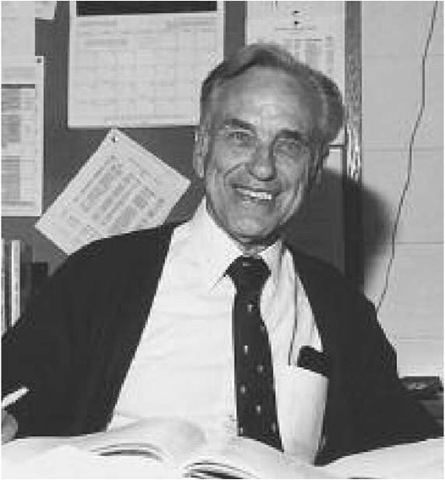(1920- ) American Mineralogist
For many years, the analysis of minerals was done using a microscope and then wet chemical methods for further resolution if necessary. With the advent of X-ray analysis and spectroscopy, these old optical methods, although still used to give general results and to guide the choice of further analysis, were considered archaic for detailed analysis. Donald Bloss almost single-handedly kept these optical methods alive through all of these years and he did so using innovative new approaches. Probably the most impressive of these new techniques is the Bloss Automated Refrac-tometer, or BAR, which was patented in 1987. One of the most distinctive optical properties of minerals is the index of refraction, basically the speed at which light travels through the mineral. Just as objects appear bent as they pass from air to water, so does light bend or refract through minerals. The BAR shoots a laser beam through a mineral and then precisely measures the angle at which it bends. This angle will not only uniquely define certain minerals but can even give accurate chemistry of minerals with simple two-component solid solutions like olivine (Mg-Fe) or pla-gioclase (Na-Ca). The ultimate version of this device is to be called the automated petrographer in which a thin section (microscope slide of rock) is mapped out, including all of the minerals and their orientations. It therefore can determine composition and fabric of a rock.
Don Bloss working in his office at Virginia Tech in 1988
This is not the only device that Bloss invented. He also designed and produced the “spindle stage,” a simple microscope attachment that allows single minerals to be observed in all directions for more accurate analysis. The name Bloss is known by virtually all students of geology not for these inventions but for his popular textbooks, Crystallography and Crystal Chemistry and Introduction to the Methods of Optical Crystallography. These two books have been the standard bearers for their subjects for 40 and 30 years, respectively. Their success is based largely on his ability to inject his own teaching philosophy into the writing.
Bloss’s scientific contributions are mainly involved with defining the optical properties of a variety of minerals under a variety of conditions. Much of the information that we have on the more recent quantitative optical properties of minerals, especially concerning solid solutions, resulted from this research. He also looked at the physics of light as it passes through minerals.
Don Bloss was born on May 30, 1920, in Chicago, Illinois, where he spent his youth. He enrolled at the University of Chicago, Illinois, where he earned a bachelor of science degree in geology in 1947, Phi Beta Kappa. He remained at the University of Chicago for graduate studies and earned a master of science degree in geology in 1949 and a Ph.D. in mineralogy in 1951. He joined the faculty at the University of Tennessee at Knoxville in 1951. He moved to the University of Southern Illinois at Carbondale in 1957. In 1967, he accepted a position at Virginia Polytechnic Institute and State University (Virginia Tech) and remained there for the rest of his career. He was named the first-ever alumni distinguished professor at Virginia Tech in 1972. He also served as department chair from 1988 to 1990. He retired to professor emeritus in 1991. Bloss was a National Science Foundation Senior Postdoctoral Fellow at Cambridge University, England, and the Swiss Federal Institute, Zurich, in 1962-1963. He was also the first-ever Caswell Silver Distinguished Visiting Professor at the University of New Mexico in 1981-1982. Bloss is a chess enthusiast and has written four books on the subject, including one with his grandson, Andrew Kensler, entitled Sammy Seahorse Teaches Chess.
Don Bloss has led a very productive career. He is an author of some 70 articles in international journals as well as six geology books, one chapter in a topic, and numerous entries in topics, as well as papers in collected volumes. Many of these studies define the state of the science for optical properties of minerals among others. These research contributions have been recognized in terms of honors and awards. Besides those already mentioned, Bloss received the Award of Merit and Honor from the State Microscopical Society of Illinois, the Ernst Abbe Award from the New York State Microscopical Society, and he was inducted into the Hall of Fame at the Carl Schurz High School, Chicago, Illinois. He also had the mineral “blossite” named after him.
Bloss has also performed service to the profession. He was president (1977) and vice president (1976) of the Mineralogical Society of America, among numerous other positions, panels, and committees. He was also of service to the Geological Society of America and the National Science Foundation. Bloss served as chief editor for American Mineralogist in 1972-1975.

